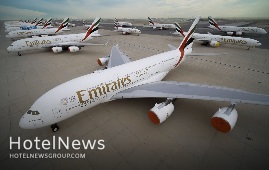
In a move to expand its operations in Australia, Emirates has announced it will increase its services to the country.Starting October 1st, Emirates will upgrade its second daily flight between Dubai and Brisbane (EK430/431) to an Airbus A380.This upgrade will significantly increase passenger capacity and provide a more comfortable and relaxed travel experience for passengers. In addition, Emirates will launch a second daily service between Dubai and Perth on December 1st, operated by a Boeing 777-300ER.This move demonstrates Emirates' commitment to expanding and strengthening its presence in the Australian market.
Create: Feb 23, 2024 Edit: Feb 23, 2024 International News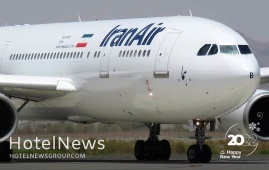
Pakistan International Airlines (PIA) has resumed direct flights to Iran’s Mashhad, after a five-year gap to develop people-to-people contacts, local media reported on Thursday. The development took place following the serious efforts of the Iranian Embassy in Islamabad to facilitate air travel between the two neighboring countries and to boost the tourism industry. Earlier this month, Chief Executive of PIA Air Marshal Arshad Malik during a meeting with Ambassador of Iran to Pakistan Mohammad Ali Hosseini had announced that the PIA is going to start direct flights from Lahore to Mashhad, Asian News International reported. Ambassador Hosseini in a tweet had also revealed that Iran and Pakistan had agreed on increasing efforts to promote air cooperation between Iran and Pakistan. In this regard, PIA is going to begin direct flights from Karachi to Mashhad on Jan 1, 2022. Iran Air operates one weekly flight from Tehran to Karachi and vice versa, and there are reports that Mahan Iran Airlines will resume flights from Tehran and Mashhad to Lahore. Mashhad is Iran’s holiest and second-largest city. Its raison d’être is the striking shrine complex of the eighth Shia Imam (AS) that is encircled by dozens of five-star hotels and many other accommodation centers.
Create: Jan 1, 2022 Edit: Jan 1, 2022 Regional News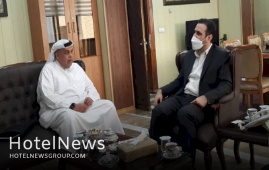
The exchange of tourists between Iran and its neighbors is expected to increase in the months to come, Iran’s deputy tourism minister Ali-Asghar Shalbafian has announced. The official made the remarks during a meeting with Hamad Obaidalla the Chief Commercial Officer of Fly Dubai Airlines on Monday. Increasing tourist exchanges with neighboring countries is on the agenda for Iran following the expansion of the flight network between Iran and the United Arab Emirates, he said. To achieve this goal, the private and public sectors will consolidate their capacities, the official added. For his part, Obaidalla said that currently, Fly Dubai Airlines operates 30 flights a week to Iran, and this capacity will grow to nearly 50 flights in the future. By relying on this capability, tourists can be directed to Iranian tourist destinations effectively, he added. Communication between the private sector of the two countries plays a crucial role in achieving executive strategies, he noted. Back in September, Cultural Heritage, Tourism, and Handicrafts Minister Ezzatollah Zarghami announced the issuance of tourist visas and the flow of foreign tourists to Iran would resume as per President Ebrahim Raisi’s order following 19 months of suspension. Currently, tourist visas are once again being issued to cultivate good grounds of hope for travel insiders. However, months of steep recession have taken its toll. Many travel insiders, hoteliers, and tour operators have faced big dilemmas such as bankruptcy, unemployment, debts, and the prospects of not being competitive on the international level. Only months into the outbreak, Zarghami’s predecessor, Ali-Asghar Mounesan, lamented that the number of foreign travelers to Iran was drastically plunged due to the pandemic. “Tourism of the country was growing before the corona [outbreak], its revenues reached $11.7 billion in 2019, which accounted for 2.8% of GDP, nearing the average share of tourism in the world GDP, which was 3.2 percent,” Mounesan said. He added 8.7 million foreign nationals visited Iran during the [Iranian] year (1398), adding that Iran was ranked as the second fastest-growing country in tourism based on data compiled by the World Tourism Organization. The average of international travels to and from Iran fell by 80 percent during the past Iranian calendar year 1399 (ended on March 20, 2021) from a year earlier caused by various coronavirus restrictions. Optimistic forecasts, expect the country would achieve a tourism boom after coronavirus is contained, believing its impact would be temporary and short-lived for a country that ranked the third fastest-growing tourism destination in 2019. UNWTO’s Panel of Experts foresees a rebound in international tourism in the current year, mostly in the third quarter. However, some experts suggest the rebound could occur only in 2022. The Islamic Republic expects to reap a bonanza from its numerous tourist spots such as bazaars, museums, mosques, bridges, bathhouses, madrasas, mausoleums, churches, towers, and mansions, of which 26 are inscribed on the UNESCO World Heritage list. Under the 2025 Tourism Vision Plan, Iran aims to increase the number of tourist arrivals from 4.8 million in 2014 to 20 million in 2025.
Create: Dec 20, 2021 Edit: Dec 22, 2021 Regional News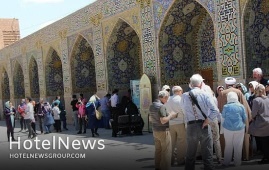
A number of Russian travel agents and tour operators have recently arrived in Iran for a week-long familiarization tour, Mehr reported on Friday. The group, which entered the Islamic Republic on Thursday through Imam Khomeini International Airport, was scheduled to travel earlier this year following the implementation of Iran-Russia visa waiver for group tours; however, because of coronavirus restrictions, they were forced to postpone the journey, the report added. Supported by Mahan Airlines, the group will tour the southern cities of Kerman, Mahan, Shiraz, and central city of Isfahan as well as the UNESCO-registered Lut Desert in the barren heartland of Iran. The tour will be held observing strict health protocols and social distancing rules. Earlier in June, the former Iranian tourism minister Ali-Asghar Mounesan finalized work on a bilateral visa-free agreement for tourist groups with Russia. In 2017, former Iranian President Hassan Rouhani and his Russian counterpart Vladimir Putin inked a visa-free agreement for tourist groups. A joint technical committee has been developing an action plan for the previously agreed visa-free travel arrangements since then, in order to put the agreement into effect. However, the outbreak of the coronavirus put a halt to the agreement. Based on the 2017 agreement tour groups of 5 to 50 people heading to [easternmost parts of] Russia from Iran or vice versa are granted a visa-free stay of up to 15 days. Back in May, Mostafa Sarvari, who presides over the tourism marketing and advertising office of the Iranian Tour Operators Association, announced many Russian tourists are eager to travel to Iran, recounting his Russian counterparts. “Many [potential] Russian travelers are motivated to visit novel and lesser-known destinations such as Iran that could be a safe and attractive destination,” he said. “According to Russian tourism experts, the feedback from Russian tourists who have traveled to Iran has been very positive, and its reflection, especially on social media, has caused a great deal of enthusiasm and interest.” According to Ebrahim Pourfaraj, who heads the Iranian Tour Operators Association, rounds of negotiations have been held between Iranian tour operators, travel marketers, and their Russian counterparts. “We’ve been commenced talks with some Russian travel agents to put Iranian destinations on their itineraries…. And the Iranian Tour Operators Association has also entered negotiations with Russian unions for outbound tours to attract more travelers from Russia. Pourfaraj says the majority of potential Russian travelers are unaware of the vast tourist attractions that exist in every corner of Iran. “The fact is that Iran’s political and economic relations with Russia are considered as good, but this has nothing to do with attracting tourists because it is directly connected with the Russian people. It is the Russian people who must choose Iran as their destination.” Maya Lomidze, executive director of the Association of Tour Operators of Russia, had told Sputnik that the visa agreement may significantly surge the tourist flows between the two countries, just like it happened when a similar deal was signed between Russia and China. The flow of Iranian tourists to Russia increased by 50-70 percent following the operation of direct flights that connect Iran to St. Petersburg, Moscow, and Sochi, she said. Iran is taking proactive measures in line with the long-term goal of 20 million tourists by 2025.
Create: Nov 9, 2021 Edit: Nov 9, 2021 Regional News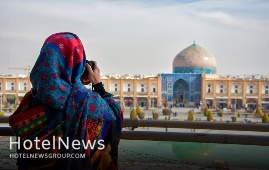
The Islamic Republic of Iran should benefit from World Cup as a considerable opportunity to promote its distinctive travel attractions, the deputy tourism minister has said. "With the World Cup being held in a neighboring country, Iran can benefit from this important event, which if carefully planned, can bring significant wins for various sectors, especially the tourism industry in the country," CHTN quoted Ali-Asghar Shalbafian as saying on Wednesday. The geographical position of Iran and its unique tourist attractions make it a potential destination for the World Cup spectators, the official added. Therefore, proper policy-making and management in collaboration with the private sector can pave the way for the widespread use of this event, he noted. Increasing the number of flights between Iran and Qatar during the event, which will be held from November 21 to December 18, 2022, as well as showcasing and introducing distinctive tourist attractions of the country to the spectators at this event are on the agenda of the tourism ministry, he explained. Back in September, Cultural Heritage, Tourism, and Handicrafts Minister Ezzatollah Zarghami announced the issuance of tourist visas and the flow of foreign tourists to Iran would resume as per President Ebrahim Raisi’s order following 19 months of suspension. However, now that the tourist visas are once again being issued to cultivate good grounds of hope for travel insiders. Months of steep recession has taken its toll. Many travel insiders, hoteliers, and tour operators have faced big dilemmas such as bankruptcy, unemployment, debts, and the prospects of not being competitive on the international level. Meanwhile, the number of people testing positive for COVID-19 has continued to fall in the Islamic Republic, curbing a stubborn fifth wave of the pandemic, which has seen daily mortalities of up to 700 in recent weeks. As of September 22, the figure dropped to below 300 as the government has devoted a great deal of effort to vaccinate citizens against the nasty virus. Some experts believe Iran is still somehow “unknown” for many potential travelers due to Western “media war”. Several estimates have been released so far on the extent of the tourism-related losses incurred by the pandemic. Only months into the outbreak, Zarghami’s predecessor, Ali-Asghar Mounesan, lamented that the number of foreign travelers to Iran was drastically plunged due to the pandemic. Tourism of the country was growing before the corona [outbreak], its revenues reached $11.7 billion in 2019, which accounted for 2.8% of GDP, nearing the average share of tourism in the world GDP, which was 3.2 percent,” Mounesan said. He added 8.7 million foreign nationals visited Iran during the [Iranian] year (1398), adding that Iran was ranked as the second fastest-growing country in tourism based on data compiled by the World Tourism Organization. Experts expect Iran to achieve a tourism boom after coronavirus contained, believing its impact would be temporary and short-lived for a country that ranked the third fastest-growing tourism destination in 2019. The Islamic Republic expects to reap a bonanza from its numerous tourist spots such as bazaars, museums, mosques, bridges, bathhouses, madrasas, mausoleums, churches, towers, and mansions, of which 26 are inscribed on the UNESCO World Heritage list. Under the 2025 Tourism Vision Plan, Iran aims to increase the number of tourist arrivals from 4.8 million in 2014 to 20 million in 2025.
Create: Oct 31, 2021 Edit: Oct 31, 2021 Regional News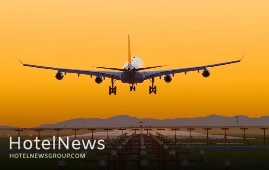
Russia is scheduled to lift its COVID-19 ban on flights to Iran and several other countries as of Nov. 9, the government coronavirus task force said on Thursday. Moscow stopped normal commercial flights abroad when the pandemic struck last year, but it has since been gradually relaxing the restrictions, Reuters reported. The restriction will also be eliminated on flights to the Netherlands, Sweden, Norway, Slovenia, Oman, Tunisia, and Thailand. “The flight bans dealt a heavy blow to Russia’s airlines,” Reuters said. Russian tourists eager to visit Iran Many Russian tourists are eager to travel to Iran, an Iranian travel expert said earlier in May, recounting his Russian counterparts. “Many [potential] Russian travelers are motivated to visit novel and lesser-known destinations such as Iran that could be a safe and attractive destination,” said Mostafa Sarvari who presides over the tourism marketing and advertising office of the Iranian Tour Operators Association. “According to Russian tourism experts, the feedback from Russian tourists who have traveled to Iran has been very positive, and its reflection, especially on social media, has caused a great deal of enthusiasm and interest.” In 2017, President Hassan Rouhani and his Russian counterpart Vladimir Putin inked a visa-free agreement for tourist groups.
Create: Oct 16, 2021 Edit: Oct 16, 2021 International News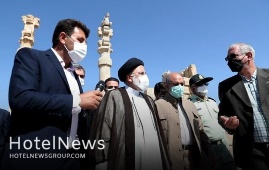
Iranian President Seyyed Ebrahim Raisi on Thursday said the UNESCO-registered Persepolis is an epitome of the great Persian art. Persepolis displays the great artistic achievements of Iranians from past millennia, which are still remarkable and admirable after so many centuries, the president said. He made the remarks during his visit to the prestigious site, which was once the ceremonial capital of the mighty Achaemenid Empire (c. 550 – 330 BC). [The ruins of] Persepolis is also conveying a message to oppressors warning them of the fate of those who are cruel to humanity, he added. The royal city of Persepolis ranks among the archaeological sites which have no equivalent, considering its unique architecture, urban planning, construction technology, and art. Persepolis, also known as Takht-e Jamshid, whose magnificent ruins rest at the foot of Kuh-e Rahmat (Mountain of Mercy) is situated 60 kilometers northeast of the city of Shiraz in Fars province. The city was burnt by Alexander the Great in 330 BC apparently as revenge to the Persians because it seems the Persian King Xerxes had burnt the Greek City of Athens around 150 years earlier. The city’s immense terrace was begun about 518 BC by Darius the Great, the Achaemenid Empire’s king. On this terrace, successive kings erected a series of architecturally stunning palatial buildings, among them the massive Apadana palace and the Throne Hall (“Hundred-Column Hall”). This 13-ha ensemble of majestic approaches, monumental stairways, throne rooms (Apadana), reception rooms, and dependencies is classified among the world’s greatest archaeological sites. Persepolis was the seat of the government of the Achaemenid Empire, though it was designed primarily to be a showplace and spectacular center for the receptions and festivals of the kings and their empire. The site is marked by a large terrace with its east side abutting the Kuh-e Rahmat (“Mount of Mercy”). The other three sides are formed by a retaining wall, varying in height with the slope of the ground from 13 to 41 feet (4 to 12 meters); on the west side, a magnificent double stair in two flights of 111 short stone steps leads to the top. On the terrace are the ruins of several colossal buildings, all constructed of a dark gray stone (often polished to a marble-like surface) from the adjacent mountain. According to Britannica, the stone was cut with the utmost precision into blocks of great size, which were laid without mortar; many of them are still in place. Especially striking are the huge columns, 13 of which still stand in the audience hall of Darius I (the Great; reigned 522–486 BC), known as the Apadana, the name given to a similar hall built by Darius at Susa. There are two more columns still standing in the entrance hall of the Gate of Xerxes, and a third has been assembled there from its broken pieces. In 1933 two sets of gold and silver plates recording in the three forms of cuneiform—ancient Persian, Elamite, and Babylonian—the boundaries of the Persian empire were discovered in the foundations of Darius’s hall of audience. Several inscriptions, cut in stone, of Darius I, Xerxes I, and Artaxerxes III indicate to which monarch the various buildings were attributed.
Create: Oct 16, 2021 Edit: Oct 16, 2021 Regional News
Two hundred flights were cancelled at Lisbon airport on Saturday at the start of a two-day strike by Groundforce handling company workers, with more cancellations likely before the action ends on Sunday evening, the company that manages Portugal’s airports (ANA) said. A spokesman for the Union of Airport Handling Technicians, which called the strike, told local news agency Lusa that about 100 per cent of workers had taken part in the strike in Lisbon on Saturday, the busiest airport in the country. The strike has had a huge impact on Portuguese flag carrier TAP, which uses Groundforce’s handling services, but it has not affected low-cost airlines. Groundforce workers are demanding that the handling company, which is in serious financial difficulties due to the coronavirus pandemic, pay wages without any delay, along with this year’s holiday pay. The strike mainly affects the operation of Lisbon airport, and has little impact on the other nine Portuguese airports, ANA chief executive Thierry Ligonnière said. “We still anticipate difficulties tomorrow and a progressive return to normal on Monday,” Mr Ligonnière told reporters. Groundforce is 50.1 per cent owned by the Portuguese firm Pasogal and 49.9 per cent by the TAP-Air Portugal group, which in turn is 72.5 per cent controlled by the Portuguese state. TAP offered to lend the money necessary for Groundforce to pay the holiday pay to its workers, but the proposal was turned down by the handling company.
Create: Jul 18, 2021 Edit: Jul 18, 2021 International News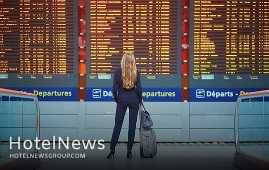
The restart of international travel could be seriously delayed without worldwide reciprocal recognition of all approved COVID-19 vaccines, says the World Travel & Tourism Council (WTTC).The global tourism body, which represents the global private Travel & Tourism sector, has issued its warning following concerns tourists face being turned away at the borders because countries don’t have a common list internationally recognised and approved COVID-19 vaccines.This comes just days after a number of British holidaymakers, who had been administered the Indian Covishield batch of the Oxford/AstraZeneca vaccine, were rejected entry into Malta despite the drug being chemically identical to the UK-made vaccine.Over the past few weeks reports of holidaymakers facing obstacles to entry have been on the rise, with some even being prevented from boarding their flights to destinations.WTTC believes that once again, the lack of international coordination to agree on a list of approved vaccines, is creating yet another major stumbling block for the restart of international travel.This comes despite most vaccines have secured the approval of the World Health Organisation (WHO) or Stringent Regulatory Authorities (SRAs), such as the UK’s the Medicines and Healthcare products Regulatory Agency (MHRA) and the Food and Drug Administration in the US, and the European Medicines Agency (EMA).Reports of travellers being turned away because they have the ‘wrong’ vaccine batches or ‘unrecognised’ vaccines have fueled concern from consumers, deterring them from booking and thereby damaging the already struggling Travel & Tourism sector.The plea for reciprocal recognition for all vaccines and vaccine batches forms part of WTTC’s four new guidelines which are aimed at safely resuming international mobility and save the millions of jobs and livelihoods which depend on this sector, while kick-starting the global economic recovery.Virginia Messina, Senior Vice President WTTC, said: “Reciprocal recognition of all vaccine types and batches is essential if we are to avoid any further unnecessary and damaging delay to restarting international travel.“The failure of countries to agree on a common list of all approved and recognised vaccines is of huge concern to WTTC, as we know every day travel is curbed, more cash-strapped Travel & Tourism businesses face even greater strain, pushing ever more to the brink of bankruptcy.“We can avoid this by having a fully recognised list of all the approved vaccines – and vaccine batches – which should be the key to unlocking international travel, not the door to preventing it.“It will also give holidaymakers and travellers the confidence they need to book trips, flights and cruises, confident in the knowledge that their fully-vaccinated status will be internationally recognised.”WTTC says the restoration of safe international travel can be achieved by following its four guidelines.Through a combination of COVID-19 testing, vaccination, digital health travel passes and the use of health and safety protocols, such as wearing face masks, safe international mobility can resume while at the same time saving millions of jobs and livelihoods which depend on the sector and kick-starting the global economic recovery. WTTC’s fundamental guidelines to restore international mobility while safeguarding public health include: Appropriately reduced protocols for vaccinated travellers, including no need for testing or quarantine for those fully vaccinated. Global recognition for international travel of all vaccines authorised for use and deemed safe and effective by the WHO or by the WHO recognised SRAs.A data driven, risk-based and internationally harmonised approach to re-establishing freedom of movement, that is consistent across countries, easy to communicate and clearly understood by travellers.Global adoption of ‘digital health passes’ which enable travellers to easily obtain and verify their vaccination status, negative COVID test result or natural immunity from a previous infection. These must work with existing border control and travel operator systems accepted by all countries. Digital verification of a traveller’s COVID status prior to travel will avoid lengthy and unsafe queues in transport hubs and terminals.Continued implementation of high-quality health and safety standards throughout all areas of the Travel & Tourism sector, including continued adoption of the WTTC’s Safe Travel Protocols and Safe Travel Stamp, with the continued wearing of face masks in crowded and enclosed areas as well as on all forms of public transport. WTTC advocates the full implementation of these proportionate and responsible guidelines for travel during over the next few months, as many travel restrictions begin being eased as major travel markets begin to reopen.This is against the backdrop of a successful vaccination roll out, with a subsequent decrease in deaths, cases, and hospitalisations in many countries. However, variants will continue to be cause of concern as the world struggles to emerge from the effects of the pandemic.
Create: Jul 17, 2021 Edit: Jul 17, 2021 International News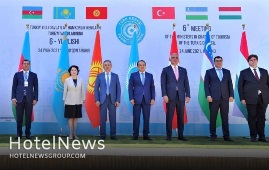
The 6th Meeting of the Ministers in Charge of Tourism of the Turkic Council convened on 24 June 2021 in Kokand,Uzbekistan. The meeting was hosted by the Deputy Prime Minister – Minister of Tourism and Sports of the Republic of Uzbekistan H.E. Mr. Aziz Abdukhakimov, moderated by the Secretary General of the Turkic Council H.E. Baghdad Amreyev and attended by the Chairman of the State Tourism Agency of the Republic of Azerbaijan, H.E. Fuad Nagiyev; Minister of Culture and Sports of the Republic of Kazakhstan H.E. Aktoty Raimkulova; Minister of Culture and Tourism of the Republic of Turkey H.E. Mehmet Nuri Ersoy; Deputy Chairman of the Cabinet of Ministers, Deputy Minister of Economy and Finance of Kyrgyz Republic H.E.Seyit Rysaliev and Ambassador of Hungary to Uzbekistan H.E.Peter Szanto. Secretary General Baghdad Amreyev briefed the Parties regarding the current state of tourism and developments, as well as the socio-economic implications and reflections of the Covid-19 pandemic in the regional and global level. Informing the Parties on the tourism relations among the Member States, as well as undertakings and activities of the Secretariat, Secretary General expressed that the close collaboration and coordination among the Turkic countries are of utmost importance to mitigate the negative effects of the pandemic, as well as attract more tourists to the region in the post-pandemic period. Secretary General of the Turkic Council communicated the new programs and projects namely “Turkic World Tourism Capital”, “Tabarruk Ziyorat” and “Tourism Map of the Turkic World” and underlined the importance of increasing the number of flights between the major cities of the Member and Observer States. The Secretary General also noted that vocational training programs provided in the field of tourism under the umbrella of the Turkic Council created a unique opportunity for the tourism employees in developing their skills, until now more than 1000 employees benefited from these trainings, the Secretariat will further coordinate the efforts for the continuation of the training and capacity building programs. As the outcomes of the Ministerial Meeting, the Ministers agreed to launch “Turkic World Tourism Capital” project in order to promote tourism in the region, in which one of the cities from the Member States will be designated as “Turkic World Tourism Capital” annually. At the end of the Meeting, city of Kokand announced as the first “Turkic World Tourism Capital” until the next Ministerial Meeting on Tourism of the Turkic Council. In this regard, international conferences and various events will be held in Kokand with participation of public sector, civil society, private sector, academia and other relevant actors from the Member States to promote tourism in the city, as well as promote the city in the Member States and the region. Ministers in Charge of Tourism exchanged experience, information and the precautions taken by the Member States for the safe travel of the tourists during the pandemic; discussed the current tourism relations among the Member States and ways to carry forward the cooperation in the sphere of tourism, as well as prospective plans in the post-pandemic period. Ministers agreed to work on the details of the “TabarrukZiyorat” project and expressed their readiness to involve the holy places of the respective countries to the project. Parties agreed to prepare the “Tourism Map of the Turkic World” to list the main historical, cultural and touristic destinations in the Turkic World, which will be the reference project in determining the main touristic destinations in the Member States. Following the Ministerial Meeting, Secretary General held bilateral meetings with the Ministers in Charge of Tourism of the Turkic Council Member States. During the bilateral meetings, Secretary General and Ministers discussed the cooperation opportunities, as well as the future plans and projects in the field of tourism to realize in the bilateral and multilateral level.
Create: Jun 28, 2021 Edit: Jun 28, 2021 International News
Iran’s flag carrier IranAir is set to resume flights to and from Pakistan and France after weeks of suspension imposed to curb the spread of a novel coronavirus variant into the Islamic Republic. The Civil Aviation Organization of Iran (CAOI) allowed air travel to and from Pakistan and France after dropping the two countries from the red list due to the coronavirus pandemic. CAOI Spokesman Mohammad Hassan Zibakhsh said that flights to and from Islamabad and Paris had been resumed on Tuesday after a two-month suspension, Fars reported on Sunday. “However, Iran will continue to enforce a tough ban on flights to 13 countries where the highly-infectious British variant of the coronavirus has not been fully contained,” Zibakhsh explained. The official said Pakistan and France will remain among the 26 countries which still have a high rate of infection to the virus, adding that flights to those countries will continue with restrictions.
Create: Jun 20, 2021 Edit: Jun 21, 2021 Regional News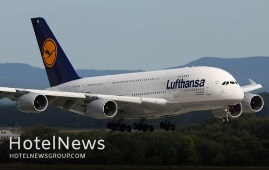
German airline Lufthansa is scheduled to resume flights from the Austrian capital, Vienna, to Tehran following months of suspension over the coronavirus outbreak. “Lufthansa will resume flights between Tehran and Vienna as of July 17,” Alireza Majzubi, an official at Tehran's Imam Khomeini International Airport announced on Friday. The airline will increase its flight schedule from three to five flights a week as well, the official added. Over the past couple of months, many countries, including the Islamic Republic, imposed travel restrictions to help curb the spread of novel coronavirus. In this line, incoming and outgoing flights have been suspended, and road travels restricted to a great extent.
Create: Jun 12, 2021 Edit: Jun 12, 2021 Regional News
